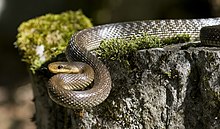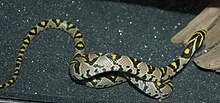
The corn snake, sometimes called red rat snake, is a species of North American rat snake in the family Colubridae. The species subdues its small prey by constriction. It is found throughout the southeastern and central United States. Though superficially resembling the venomous copperhead and often killed as a result of this mistaken identity, the corn snake lacks functional venom and is harmless. The corn snake is beneficial to humans because it helps to control populations of wild rodent pests that damage crops and spread disease.

Pantherophis obsoletus, also known commonly as the western rat snake, black rat snake, pilot black snake, or simply black snake, is a nonvenomous species of snake in the family Colubridae. The species is native to central North America. There are no subspecies that are recognized as being valid. Its color variations include the Texas rat snake. Along with other snakes of the eastern United States, like the eastern indigo snake and the eastern racer, it is called “black snake”.
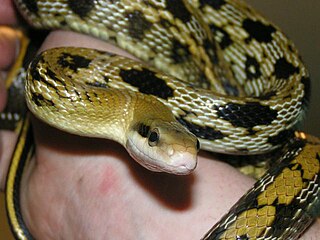
The beauty rat snake, also called the beauty ratsnake, the beauty snake, or the cave racer, is a species of snake in the family Colubridae. The species is native to the eastern and southeastern regions of Asia. It is a long, thin, semi-arboreal species of snake with several recognized subspecies. This constrictor feeds on rodents, and though it is favored in some locations as a natural pest control or pet, it is also considered an invasive species in other locations.

The Jamaican boa, Jamaican yellow boa or yellow snake is a boa species endemic to Jamaica. No subspecies are recognized. Like all other boas, it is not venomous.

Elaphe is a genus of snakes in the family Colubridae. Elaphe is one of the main genera of the rat snakes, which are found in many regions of the northern hemisphere. Elaphe species are medium to large constrictors by nature.
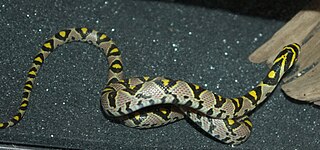
The mandarin rat snake is a species of nonvenomous colubrid snake endemic to Asia. It is closely related to Euprepiophis conspicillata, the Japanese forest rat snake. Mandarin rat snakes are one of the most popular rat snakes found in the pet trade.

Oreocryptophis porphyraceus is a rat snake species, commonly called the black-banded trinket snake, red bamboo snake, found in mid to upper-level elevations of forested hills in southeastern Asia, ranging from evergreen tropical to dry seasonal forests depending on the subspecies and locality. It is the only member of the genus Oreocryptophis, but it was formerly placed in Elaphe.

Coelognathus radiatus, commonly known as the radiated ratsnake, copperhead rat snake, or copper-headed trinket snake, is a nonvenomous species of colubrid snake.

The Trans-Pecos rat snake or Davis Mountain rat snake, is a species of medium to large, nonvenomous rat snake in the family Colubridae. Bogertophis subocularis is endemic to the Chihuahuan Desert.

The Texas rat snake is a subspecies of the black rat snake, a nonvenomous colubrid. It is found in the United States, primarily within the state of Texas, but its range extends into Louisiana, Arkansas and Oklahoma. It intergrades with other subspecies of Elaphe obsoleta, so exact range boundaries are impossible to distinguish. The epithet lindheimeri is to honor the German-American naturalist Ferdinand Jacob Lindheimer, who collected the first specimen in New Braunfels, Texas.

Pantherophis emoryi, commonly known as the Great Plains rat snake, is a species of nonvenomous rat snake in the family Colubridae. The species is native to the central part of the United States, from Missouri to Nebraska, to Colorado, south to Texas, and into northern Mexico.
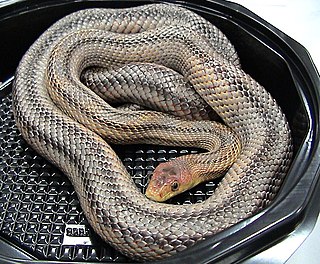
Pantherophis bairdi is a species of harmless snake in the family Colubridae. The species is native to the southwestern United States and adjacent northeastern Mexico. No subspecies are recognized as being valid.

Elaphe schrenckii is a species of nonvenomous snake in the family Colubridae. The species is indigenous to Northeast Asia.

Elaphe carinata, the king ratsnake, is a species of Colubrid snake found in Southeast and East Asia.
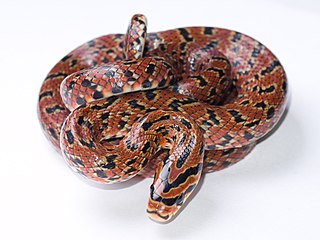
Euprepiophis conspicillata, commonly known as the Japanese forest rat snake, is a species of nonvenomous colubrid snake endemic to Japan. Its Japanese common name, jimuguri, roughly translates to "the burrower". It is closely related to Euprepiophis mandarinus, the Mandarin rat snake.
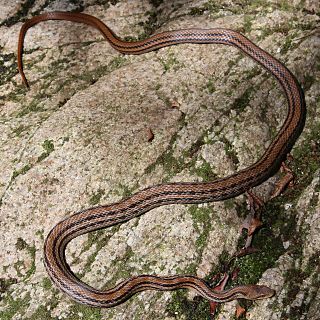
Elaphe quadrivirgata, commonly known as the Japanese four-lined ratsnake or the Japanese striped snake, is a species of non-venomous colubrid snake native to Japan.

Euprepiophis is a genus of nonvenomous colubrid snakes, containing three species of Asian rat snakes which were formerly assigned to the genus Elaphe. They were separated from Elaphe in 2002 by Utiger et al. following evidence from DNA analysis. They are true rat snakes but are not as closely related to other European, Asian, or North American rat snakes as their former place in Elaphe might suggest.

Coelognathus is a genus of seven species of rat snakes in the subfamily Colubrinae of the family Colubridae. The species, which are native to South Asia and Southeast Asia, were formerly assigned to the genus Elaphe. Based on morphological evidence and protein similarities, in 2001, Helfenberger revalidated the name Coelognathus that had originally been proposed by Leopold Fitzinger in 1843. The distinction between Coelognathus and Elaphe was further supported by mitochondrial DNA sequence and additional morphological evidence in 2005.
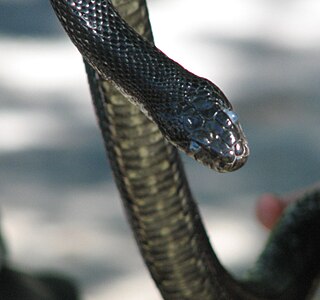
Pantherophis alleghaniensis, commonly called the eastern rat snake, is a species of nonvenomous snake in the family Colubridae. The species is endemic to North America.

Elaphe anomala commonly known as the Korean rat snake, GuReongEe is a non-venomous species of colubrid snake known from China and Korea. Its common names include Amur ratsnake, southern Amur ratsnake. It is a semi-arboreal snake that can be found in grasslands, dry scrub, rocky areas, and on the banks of rivers and lakes. It grows to 150–180 cm (59–71 in).
